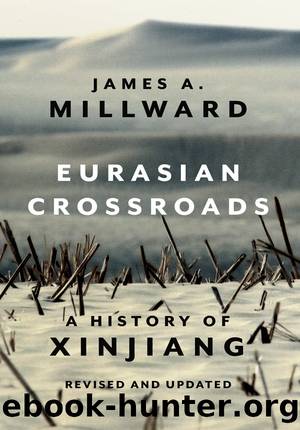Eurasian Crossroads: A History of Xinjiang, Revised and Updated by James Millward

Author:James Millward [Millward, James]
Language: eng
Format: epub
Tags: History/Asia/China, HIS037060, HIS008000, History/Modern/19th Century
ISBN: 9780231555593
Publisher: ColumbiaUP
Published: 2021-12-07T00:00:00+00:00
Members of a Kazakh family in their yurt, after erecting it on summer pastures in the Tianshan (photo: J. Millward 1990)
Of the official nationality groups in Xinjiang, the Kazakhs, Kirghiz, Hui (Chinese Muslim), Mongols, Tajiks and Sibe were assigned autonomous counties, districts and/or prefectures. The province as a whole was of course designated an Uyghur Autonomous Region in light of the Uyghur majority. In practice, âautonomyâ in this system means that representatives of the various recognised nationalities serve on local representative bodies (not popularly elected) and as functionaries and officials in government offices. The PRC went to great lengths to train non-Chinese cadres in educational institutions at both regional and national levels. However, the autonomous counties and prefectures in mid-1950s Xinjiang all included multiple nationality groups (the smallest number is six different nationalities, in Chapchal and Tashkurgan), and in only twelve of the twenty-seven autonomous units did the eponymous nationality constitute a majority. Moreover, the power of any one minority group is further limited by the nesting of autonomous counties of one nationality within prefectures of another, the whole arrangement of course lying within the Uyghur autonomous region. In practice too, while the chairmen of each autonomous area were members of the nationality with a demographic plurality in that area, the ranking vice-chairmen were Han Party members. Moreover, each âautonomousâ unit remained answerable to central authorities and to the Party, whose Xinjiang department heads were almost all Han. In fact, the Xinjiang branch of the Chinese Communist Party, which had been under the northwestern Bureau in Xiâan, now answered directly to the Central Party offices in Beijingâin this way, supervision after the formation of the XUAR was more centralised than before. Finally, although autonomous areas did form their own police forces, military command lay outside the autonomous area structure, as did the Bingtuan state farm and militia system (discussed below). The system of local and regional autonomous areas, then, although it placed members of the various recognised ethnic groups at each level of government in Xinjiang, does not provide what most people would understand to be âautonomyâ.14
Download
This site does not store any files on its server. We only index and link to content provided by other sites. Please contact the content providers to delete copyright contents if any and email us, we'll remove relevant links or contents immediately.
Women and Jewish Marriage Negotiations in Early Modern Italy by Howard Tzvi Adelman(408)
Warrior King by Wilbur Smith(365)
18 real-life stories of serial killers and murderers with solved and unsolved killings from the USA, UK, Europe, and beyond. by Ben Oakley(287)
The Battle of Austerlitz by 50minutes(280)
Violence and Emotions in Early Modern Europe by Susan Broomhall;Sarah Finn;(274)
Who's Who in the Zulu War, 1879: The British by Adrian Greaves Ian Knight(272)
The American Crisis by Unknown(266)
Youth, Heroism and War Propaganda: Britain and the Young Maritime Hero, 1745â1820 by D. A. B. Ronald(239)
The Seeker by S. G. MacLean(229)
The Origins of French Absolutism, 1598-1661 by Alan James(220)
The Dutch East India Company and British East India Company: The History and Legacy of the Worldâs Most Famous Colonial Trade Companies by Charles River Editors(213)
The Traitor of Colditz by Robert Verkaik(200)
Invisible Worlds by Peter Marshall(200)
A Genius for Confusion by Richard M. Fried(199)
The Thirty Years War â Complete by Friedrich Schiller(199)
Fires of Faith by Catholic England under Mary Tudor(196)
Interest and Connection in the Eighteenth Century by Jacob Sider Jost(194)
The Opium Wars: Exploring the Addiction of Empires from Beginning to End by Ramos Adrian & Compacted History(193)
The Slave Trade in Africa by Simon Webb;(193)
